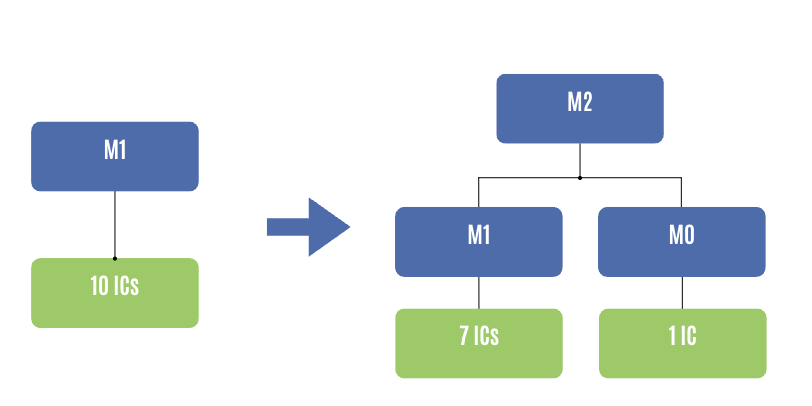How to take control of your career during organizational flattening
Many tech companies are reducing management layers to increase efficiency. Here's what that means for your EM career.
This article is written by Fahim ul Haq.
Fahim ul Haq is the co-founder and CEO of Educative, the world's leading upskilling platform for and by developers. He is a former software engineer at Microsoft and Facebook with a deep passion for creating better, more efficient ways for developers to master in-demand skills.
To succeed in the current market, many tech companies are flattening their organizational structures. Meta has led the charge, calling 2023 their "year of efficiency."
So how did this trend start?
Companies like Meta grew exponentially over the last two years. But the hiring freeze left them with more managers than they needed—and not enough ICs to keep building products.
The flattening of organizations has many associated advantages such as:
Simpler decision-making processes with less yellow tape
More flexibility to shift and adapt for business goals
Increased autonomy for individual contributors
Naturally, the trend towards flatter organizations raises significant questions for managers:
What happens to my role when management layers are removed?
How can I continue growing my career?
Considering the turbulence within the tech industry, it’s only natural to have a plan in place in case your org decides to flatten.
I’ll discuss the following topics and how to take control of your career:
How flattening the org structure impacts engineering managers
How engineering managers should negotiate organizational flattening
Next steps for engineering managers and developer teams
How flattening the org structure impacts engineering managers
Tech startups begin as flat organizations and build hierarchies as they scale. By adding management layers, founders can delegate more IC work and focus on high-level company objectives.
To illustrate how a flat organization develops a hierarchical structure and then flattens again, I’ll share the scenario below:
Early stage org structures
A single manager (M1) oversees a team of IC reports. Once the team surpasses 10 ICs, the M1 is at capacity. To keep the org growing:
M1 is promoted to M2. M2 is now a "manager's manager."
IC is promoted to M1.
IC is promoted to M0, with the goal of becoming M1 as they gain experience.
Fast growth
As more ICs join the org, more M0s and M1s are added. This process continues until M2 reaches capacity and an M3 is created.
Companies add more and more layers to increase their capacity for ICs. With larger tech companies, 2020 and 2021 were filled with trends of hoarding developers (Something I’ll talk about in another newsletter).
Flattening org structure
After a period of rapid growth, 2022 and 2023 brought abrupt hiring freezes. This has left companies with a few problems:
Many managers have extra capacity because they are overseeing small teams.
The deep hierarchy with limited ICs makes it difficult to communicate across orgs and make decisions.
At this point, many companies have begun flattening their org structures to increase efficiency. Here's what that can look like:
A company of 10,000 people has 6 management layers. There is an average team size of 6 ICs, though some teams have fewer ICs due to the slowed hiring process. In addition, the company decides to remove 20% of roles across the company, which creates new pockets of inefficiency.
The equation below can be used to estimate x, the ideal hierarchical depth prior to removing 20% of roles:
With the removal of 20% of roles, and increased capacity of M1s to include 10 ICs per team, the flattening of the organization can be summed up in this equation:
Now the ideal hierarchical depth is 4 layers. As a result, some managers will be moved down a level (e.g., from M2 to M1) or switched to an IC role.
For managers, this shift can be disappointing and complicated when considering hierarchical relationships.
If you are in this position, you may be unsure about whether to stick it out at your company or look elsewhere. Here are some important considerations to help you make an informed decision.
How engineering managers should negotiate organizational flattening
Once you know your management role is likely to change, what are your options? There are two main routes to consider:
Transition into an IC role at your current company or a new one.
Look for an engineering manager role at a new company.
The pros and cons of each route depend on your level of management experience.
Veteran engineering managers
1) Transition into IC role
If you are a veteran engineering manager, it has probably been several years since you've touched code. This means you'll have to invest a lot of time in updating your technical skills. However, there will be a steep learning curve to get back in the groove of an IC.
2) Look for EM role
You have the management experience that companies are looking for. That said, they are only hiring 1 EM for every 10 engineers, so finding the role you want could take a while.
I encourage EMs in this position to reflect on their professional interests: Do you find management rewarding? Or do you miss the technical work from your engineering days? Check in with yourself to make sure that pursuing an EM role is worth the wait.
New engineering managers
1) Transition into IC role
Good news: if you have been a manager for a year or less, the transition to IC can be relatively smooth. You can easily brush up on your technical skills and get back into the mindset of an IC.
2) Look for EM role
Unfortunately, companies generally won't hire EMs with less than 2-3 years of experience.
New managers often get the short end of the stick during organizational flattening. If you’re still interested in becoming an Engineering Manager, but decide to move to a different company, I recommend that you search for an IC role and work your way back up to management.
Aspiring engineering managers
Organizational flattening reduces the number of EM roles available—and veteran EMs will be first in line. To make yourself a compelling candidate for these limited openings, be intentional about growing your management skills:
Pursue mentorship opportunities with EMs in your org.
Seek out management learning resources and prepare to ace your engineering manager interview.
Take opportunities to perform managerial tasks (e.g., when your manager is out of town or on leave).
Keep your technical skills sharp (e.g., System Design).
Next steps for engineering managers and developer teams
Wherever you are in your management career, the best time to prepare for organizational flattening is before it happens. You can start by finding resources to grow your technical and management skills to better lead your team. Educative has a few great courses for EMs to help:
It's also important to consider how organizational flattening impacts your developers. As managers shift levels and become ICs, and developer teams are also reconfigured, your new team can struggle to align and pivot to the new tech stack.
Finding effective learning resources ahead of time will help you and your developers close skill gaps quickly and work together more effectively.
Organizational flattening can be disruptive, but that doesn't mean you have to lose momentum in your career or team’s productivity. Learn more about how Educative's courses can help keep you and your team on track.





